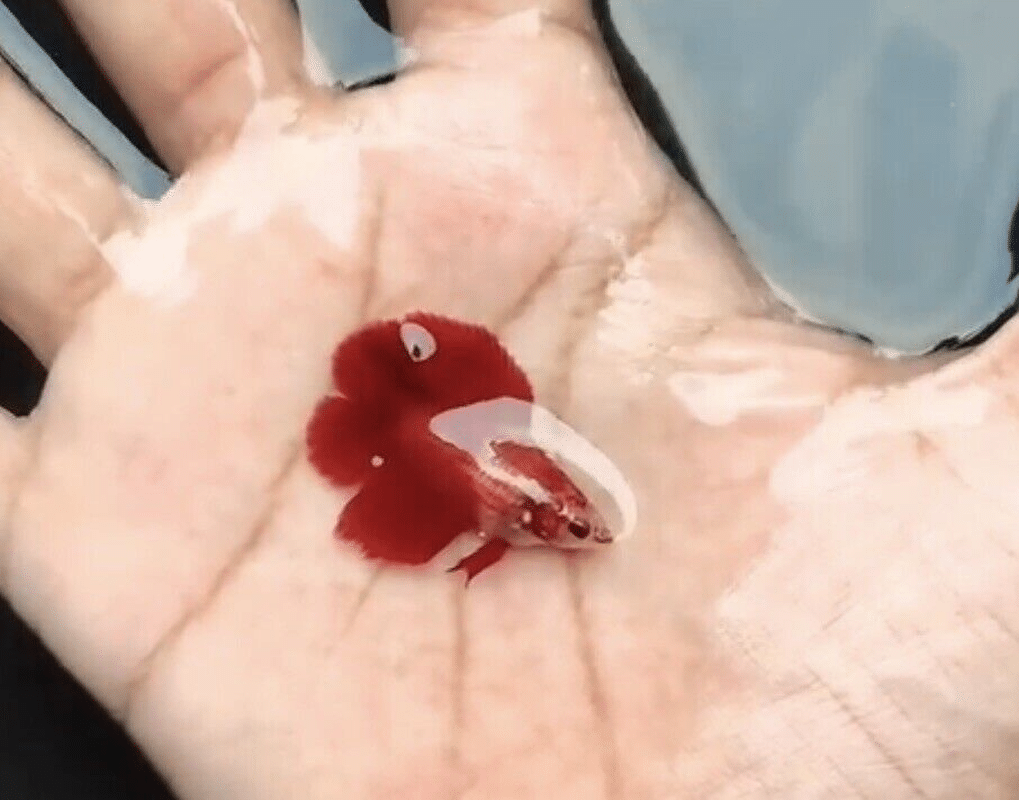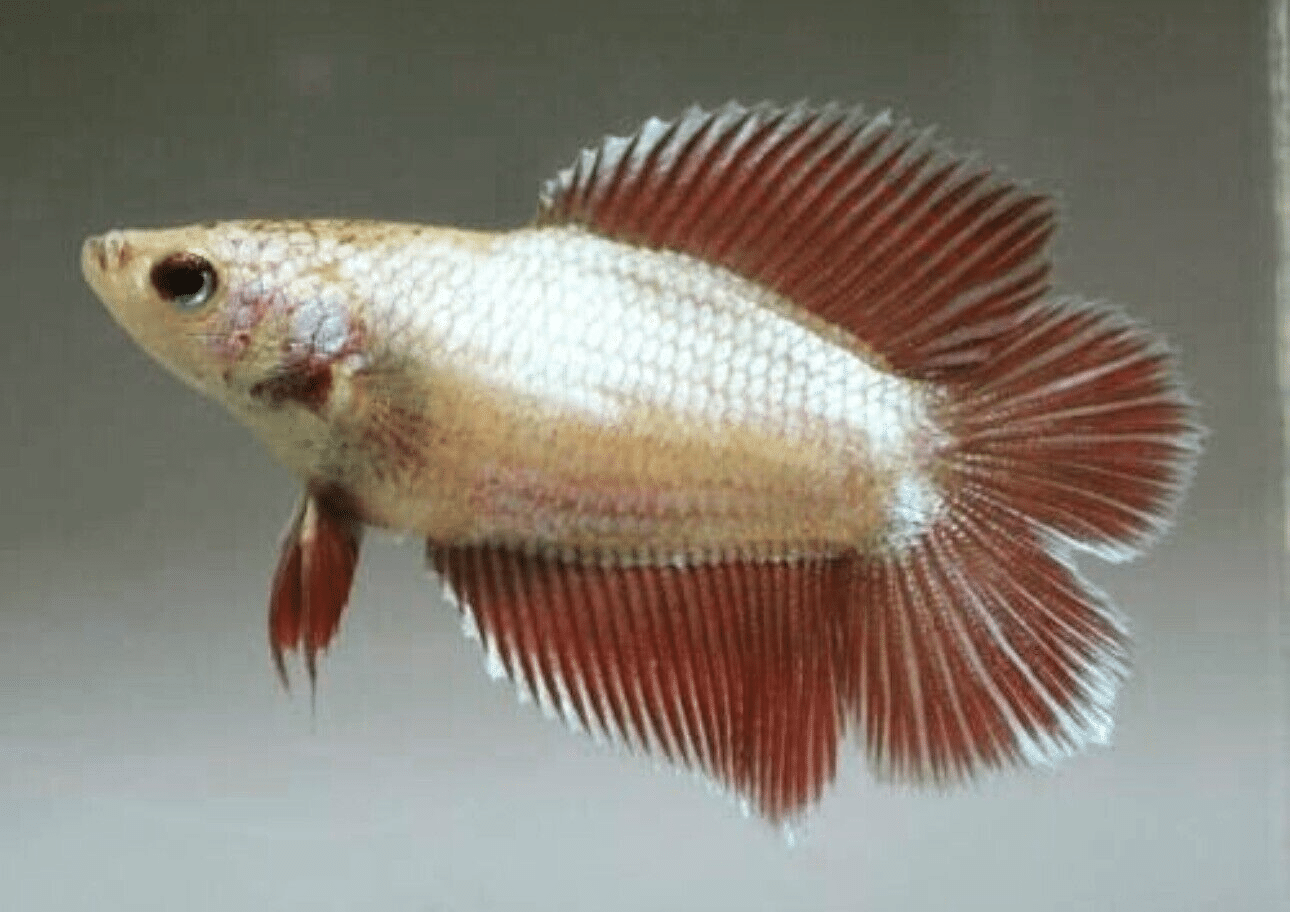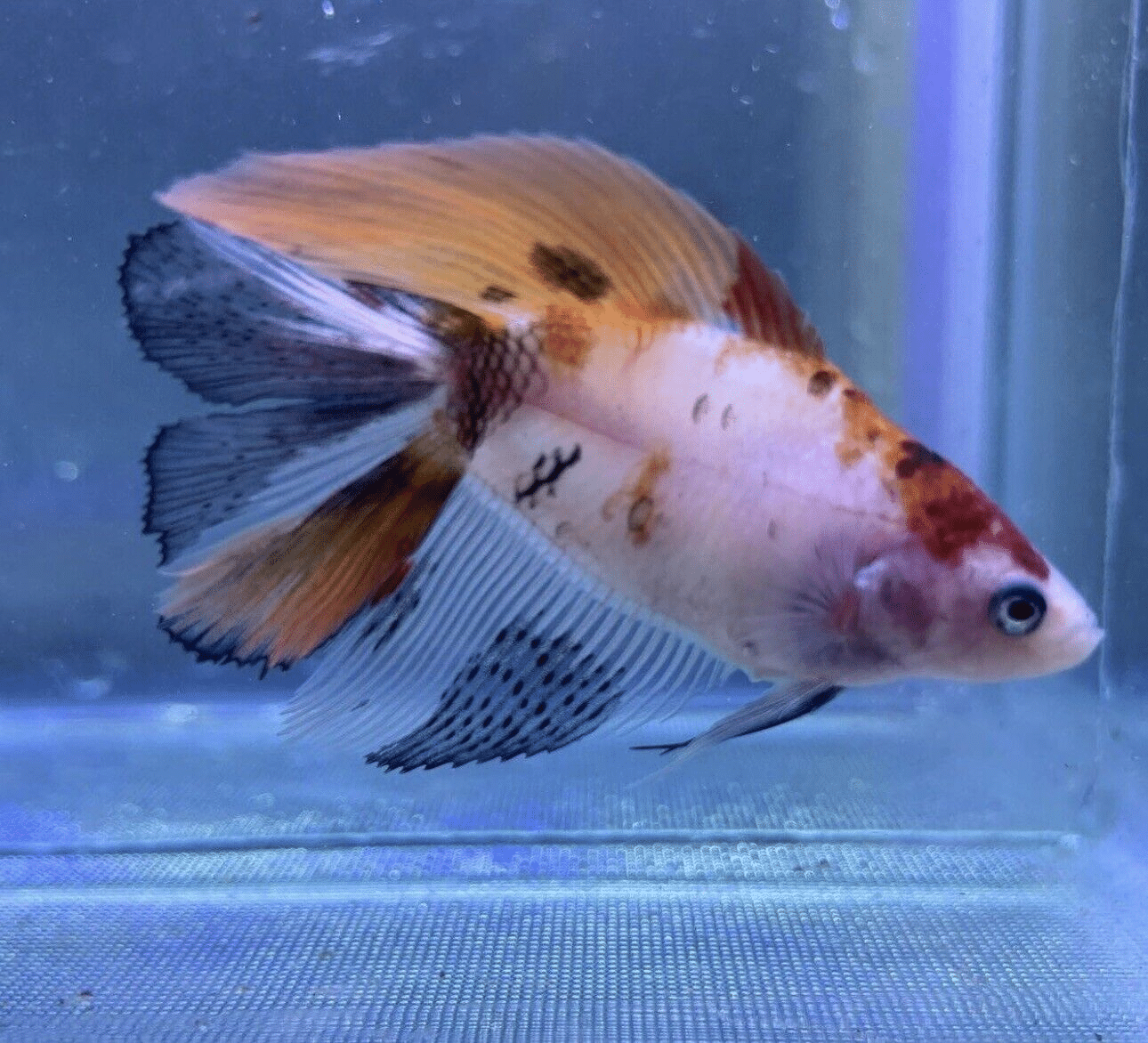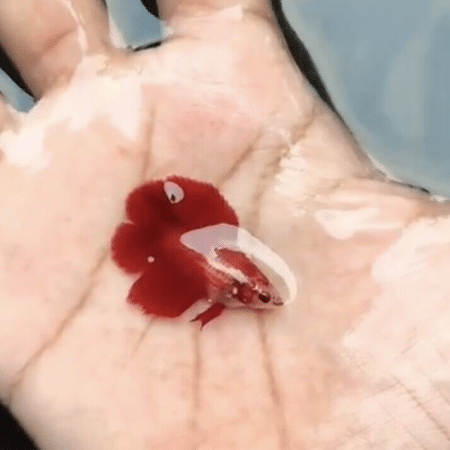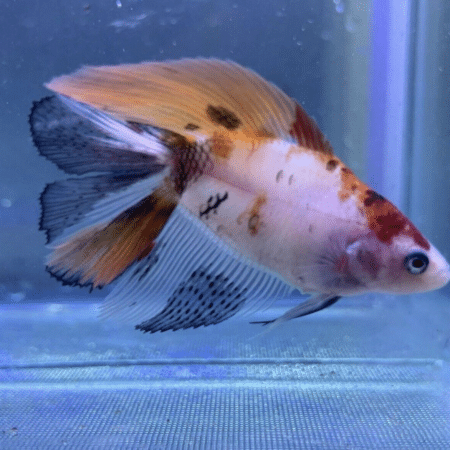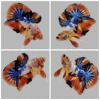Subtotal: £17.42
STUNNING DOUBLE TAIL FEMALE BETTA SPLEND BEAUTIFUL FISH Randomly Selected, Discover the Beauty of Betta Splendens for Your Aquarium, Providing Joy and Color to Any Tank
£5.99 Original price was: £5.99.£4.84Current price is: £4.84.
Welcome the Stunning Double Tail Female Betta Splend into your aquarium! This vibrant Betta splendens boasts beautiful colors and flowing fins, adding elegance to your aquatic environment. Ideal for peaceful community tanks, these lovely fish thrive with proper care and a balanced betta diet.
932 in stock
Species Introduction
The Stunning Double Tail Female Betta Splendens, scientifically known as Betta splendens, is a captivating species belonging to the Osphronemidae family. Originating from the lush freshwater environments of Southeast Asia, particularly in Thailand, these vibrant fish are often found in shallow waters, rice paddies, and slow-moving streams. Their natural habitat is characterized by dense aquatic vegetation, which provides essential cover and breeding grounds. The double tail variety is particularly admired for its unique fin structure, which features two distinct lobes that create an impressive display when swimming. This stunning morphology, combined with a wide range of colors, makes the female betta a popular choice among aquarium enthusiasts. As a member of the tropical fish category, these aquatic companions thrive in warm water conditions and are known for their vibrant personalities and social behaviors.
Care Requirements Dashboard
Essential Care Guide for Your Stunning Double Tail Female Betta Splendens
| Optimal Living Conditions | |
|---|---|
| Water Temperature | 24-27°C (75-81°F) |
| pH Level | 6.5-7.5 |
| Water Hardness | 4-12 dKH |
| Minimum Tank Size | 80L (20 gal) |
| Salinity | Freshwater |
| Care Level | Beginner Friendly |
✓ Care Level: Moderate
Tank Size: Minimum 5 gallons
Water Temperature: 76°F – 82°F (24°C – 28°C)
pH Level: 6.5 – 7.5
Water Hardness: 5 – 20 dGH
To ensure the well-being of your stunning double tail female betta, it is critical to provide a suitable environment that meets their specific care requirements. A minimum tank size of 5 gallons is recommended to allow adequate swimming space and to maintain stable water parameters. The water temperature should be kept between 76°F and 82°F (24°C and 28°C), as these fish are tropical and thrive in warmer waters. Maintaining a pH level between 6.5 and 7.5 is essential for their health, along with a water hardness of 5 to 20 dGH. Regular water changes and quality monitoring are vital to prevent stress and disease, ensuring your betta fish remains vibrant and healthy.
Natural Behavior & Temperament
The natural behavior of the stunning double tail female betta is characterized by a combination of grace and curiosity. These fish are known for their active swimming patterns, often darting around the tank, exploring their surroundings, and displaying their vibrant colors. While female bettas are generally more peaceful than their male counterparts, they can exhibit territorial behavior, especially when housed in smaller tanks or when competing for resources. In a well-planned community tank, female bettas can coexist harmoniously with other peaceful species, making them an excellent choice for community aquariums. Their social behavior is quite fascinating; they often engage in playful interactions with their tank mates, showcasing their vibrant personalities. However, it is essential to monitor their interactions closely to prevent any signs of aggression or stress.
Tank Setup Guide
Creating an ideal environment for your stunning double tail female betta involves careful consideration of tank setup. Begin with a minimum tank size of 5 gallons, as this provides ample space for swimming and exploration. The substrate should be soft and smooth, such as fine gravel or sand, to prevent injury to their delicate fins. Incorporating live plants into the aquarium not only enhances the aesthetic appeal but also provides hiding spots and natural filtration, mimicking their natural habitat. Floating plants like duckweed or water sprite can create shaded areas that bettas appreciate. Additionally, include decorations such as caves or driftwood to offer shelter and reduce stress. Ensure that the tank is equipped with a gentle filter to maintain water quality without creating strong currents, as bettas prefer calm waters. Proper lighting is also essential; aim for a moderate light level that promotes plant growth while allowing your betta to feel secure.
Water Quality Management
⚠ Important Water Parameter Notice
Regular monitoring of water parameters is crucial for the health of your betta.
To maintain a healthy environment for your stunning double tail female betta, it is imperative to manage water quality diligently. Regular water testing should be conducted to monitor pH, ammonia, nitrite, and nitrate levels. Aim for a pH between 6.5 and 7.5, as this range is optimal for their well-being. Ammonia and nitrite levels should always be at 0 ppm, while nitrate levels should be kept below 20 ppm. Conduct partial water changes of 25-50% weekly to keep the water clean and free from harmful toxins. Additionally, consider using a quality water conditioner to remove chlorine and chloramine from tap water before introducing it to the tank. Maintaining stable water temperature is equally important; use a reliable heater to keep the water within the ideal range of 76°F to 82°F (24°C to 28°C). Regularly check the heater’s functionality and calibrate it as necessary to ensure consistent conditions.
Feeding & Nutrition
✓ Feeding Level: Moderate
Diet: High-quality pellets, frozen and live foods
Feeding Frequency: 2-3 times daily
Feeding your stunning double tail female betta a well-balanced diet is essential for her health and vitality. These fish are carnivorous and thrive on a diet rich in protein. High-quality betta pellets should form the staple of their diet, providing essential nutrients and promoting vibrant coloration. Supplement their diet with frozen or live foods such as brine shrimp, daphnia, and bloodworms to enhance their nutritional intake and stimulate natural hunting behaviors. It is important to feed small amounts that can be consumed within 2-3 minutes to prevent overfeeding and maintain water quality. A feeding schedule of 2-3 times daily is recommended, allowing for a variety of foods to ensure a balanced diet. Additionally, avoid over-reliance on flake foods, as they may not provide the necessary nutrition for optimal health.
Compatibility Guide
When considering tank mates for your stunning double tail female betta, it is vital to choose species that are peaceful and non-aggressive. Female bettas can coexist harmoniously with other gentle fish, making them suitable for community tanks. Ideal tank mates include small tetras, rasboras, and guppies, which are known for their peaceful nature and compatibility. It is important to avoid housing them with fin-nipping species such as barbs or aggressive fish like cichlids, as these can stress your betta and lead to health issues. When introducing new tank mates, ensure the tank is adequately sized to provide enough space for all fish to establish territories. Monitor interactions closely during the acclimation process to prevent any signs of aggression or stress. Additionally, consider keeping multiple female bettas together in a sorority tank, as they can thrive in groups when provided with ample hiding spots and space.
Tank Mate Compatibility Guide
✅ Great Tank Mates
- Similar sized peaceful fish
- Bottom dwellers
- Robust community fish
❌ Avoid These Tank Mates
- Very small fish
- Long-finned fish
- Aggressive species
Compatibility Note: Always research specific species requirements and observe fish behavior when introducing new tank mates. Individual fish personalities can vary!
Health & Wellness
⚠ Important Health Notice
Regular health checks are essential for early detection of issues.
Maintaining the health and wellness of your stunning double tail female betta requires regular monitoring and proactive care. Common health issues in bettas include fin rot, velvet disease, and ich. Signs of illness may include changes in behavior, such as lethargy, loss of appetite, or abnormal swimming patterns. To prevent these issues, ensure that water quality is consistently monitored and maintained, as poor water conditions are often the root cause of health problems. Providing a stress-free environment with plenty of hiding spots can also help reduce the risk of disease. Regularly inspect your betta for any signs of physical abnormalities or distress, and consult with a veterinarian specializing in fish health if any concerns arise. Early detection and intervention are crucial for effective treatment and recovery.
Breeding Information
Breeding stunning double tail female bettas can be a rewarding experience, but it requires careful planning and knowledge of their reproductive behaviors. To initiate breeding, it is essential to provide a separate breeding tank with a capacity of at least 10 gallons. The breeding tank should be equipped with a gentle filter and plenty of hiding spots to create a comfortable environment for the female. The male betta will build a bubble nest at the water’s surface, which is a sign that he is ready to mate. Once the female is introduced, the male will display courtship behaviors, including flaring and swimming around her. After successful spawning, the female should be removed to prevent aggression from the male, who will guard the eggs. The eggs will hatch in about 24-48 hours, and the fry will require infusoria or finely crushed flakes for initial feeding. As they grow, gradually introduce them to larger foods, such as baby brine shrimp.
Acclimation Process
Introducing your stunning double tail female betta to a new tank environment requires a careful acclimation process to minimize stress and ensure a smooth transition. Begin by placing the sealed bag containing your betta in the new tank for about 15-20 minutes to allow the water temperatures to equalize. After this, gradually introduce small amounts of tank water into the bag over the course of an hour, allowing your betta to adjust to the new water parameters. This slow acclimation process is crucial for preventing shock and ensuring that your betta adapts comfortably to her new home. Once the acclimation is complete, gently release your betta into the tank using a net to avoid introducing any transport water that may contain harmful substances. After introducing her to the tank, monitor her behavior closely for any signs of stress or aggression as she settles into her new environment.
Long-term Care
Caring for your stunning double tail female betta over the long term involves providing consistent attention to her needs and well-being. Betta fish can live up to 3-5 years with proper care, making it essential to establish a routine that includes regular water changes, feeding schedules, and health checks. As your betta matures, monitor her growth and behavior to ensure she remains healthy and active. Regularly assess her environment, making adjustments as needed to accommodate her changing needs. Additionally, consider documenting her growth and behavior, as this can provide valuable insights into her health and happiness. Engaging with your betta through gentle interaction can also enhance her quality of life, as these fish are known to recognize their caretakers and respond positively to attention.
Natural Habitat Recreation
Recreating the natural habitat of your stunning double tail female betta is essential for her overall well-being and happiness. In the wild, these fish inhabit shallow waters with abundant vegetation, providing them with shelter and foraging opportunities. To mimic this environment in your aquarium, incorporate live plants such as Java fern, Anubias, and Amazon sword, which not only enhance the aesthetic appeal but also improve water quality through natural filtration. Create hiding spots using driftwood, rocks, or commercially available decorations that resemble natural structures. Additionally, consider using a dark substrate to simulate the riverbeds of their natural habitat. Providing a well-planted and structured environment will help your betta feel secure and reduce stress, promoting a healthy and vibrant lifestyle.
Seasonal Care Adjustments
Seasonal changes can impact the care requirements of your stunning double tail female betta, necessitating adjustments to ensure her continued health and comfort. During warmer months, it is crucial to monitor water temperature closely, as high temperatures can lead to stress and health issues. Ensure that the water temperature remains stable within the ideal range of 76°F to 82°F (24°C to 28°C) by using a reliable heater and considering the use of fans or air conditioning to prevent overheating. In cooler months, be vigilant about maintaining warmth, as sudden temperature drops can be harmful. Additionally, adjust your feeding schedule based on activity levels; during colder months, your betta may be less active and require slightly less food. Regularly assess her environment and make necessary adjustments to lighting and water quality to accommodate seasonal changes.
Expert Tips
For those looking to provide the best care for their stunning double tail female betta, consider implementing these expert tips. First, invest in a high-quality water testing kit to regularly monitor water parameters, ensuring a stable and healthy environment. Secondly, avoid overcrowding the tank; maintaining a balanced fish-to-gallon ratio will help reduce stress and aggression. Regularly change 25-50% of the water weekly to keep the environment clean and free from harmful toxins. Additionally, consider creating a varied diet that includes both pellets and live or frozen foods to provide essential nutrients and stimulate natural behaviors. Lastly, engage with your betta through gentle interaction, as this can enhance her quality of life and strengthen the bond between you and your aquatic companion.
Troubleshooting
In the event of issues arising with your stunning double tail female betta, it is crucial to have a troubleshooting plan in place. Common problems include stress, fin rot, and poor water quality. If your betta exhibits signs of stress, such as hiding, lethargy, or loss of appetite, assess her environment for potential stressors, such as aggressive tank mates or inadequate hiding spots. For fin rot, ensure that water quality is optimal and consider treating with a suitable antibacterial medication. If water quality issues arise, conduct immediate water changes and test parameters to identify the root cause. Regularly monitor your betta for signs of illness and consult with a veterinarian specializing in fish health if any concerns persist. Early detection and intervention are key to resolving issues and ensuring the well-being of your aquatic companion.
Scientific Background
The stunning double tail female betta, or Betta splendens, is a fascinating species with a rich scientific background. Belonging to the Osphronemidae family, these fish are known for their unique adaptations, including the labyrinth organ, which allows them to breathe atmospheric oxygen. This adaptation enables them to thrive in low-oxygen environments, such as stagnant waters in their native habitats. The scientific classification of Betta splendens is as follows: Kingdom Animalia, Phylum Chordata, Class Actinopterygii, Order Anabantiformes, Family Osphronemidae, Genus Betta, and Species splendens. Research into the behavioral ecology of bettas has revealed insights into their social structures, reproductive strategies, and territorial behaviors, contributing to our understanding of their care and husbandry in captivity. Conservation efforts are also underway to protect their natural habitats from degradation and pollution, ensuring the survival of this beloved species.
Advanced Care Techniques
For those seeking to elevate their care for the stunning double tail female betta, advanced techniques can enhance her quality of life and overall health. Consider implementing a planted tank setup that mimics her natural environment, incorporating a variety of aquatic plants to provide hiding spots and improve water quality. Utilize a sponge filter to maintain gentle water flow while ensuring biological filtration. Additionally, explore the use of aquascaping techniques to create a visually appealing and stimulating environment that encourages natural behaviors. Regularly engage in enrichment activities, such as introducing new decorations or changing the layout of the tank, to keep her environment dynamic and interesting. Lastly, consider participating in local betta clubs or online communities to share experiences and gain insights from fellow enthusiasts, further enhancing your knowledge and care practices.
Water Quality Parameters
Optimal Range
24-27°C
6.5-7.5
0 ppm
Caution Zone
22-24°C or 27-29°C
6.0-6.5 or 7.5-8.0
0.25-0.5 ppm
Danger Zone
<22°C or >29°C
<6.0 or >8.0
>0.5 ppm
Monitoring Tip: Test water parameters weekly and perform regular water changes to maintain optimal conditions for your aquatic friends!
Frequently Asked Questions
Q: What tank size is required for a Double Tail Female Betta?
A Double Tail Female Betta requires a minimum tank size of 20 litres to thrive. This size allows ample swimming space and helps maintain stable water parameters. Betta fish are territorial and can display aggressive behaviour, especially in smaller tanks. A larger tank also facilitates the establishment of a proper environment with plants and hiding spots, which are essential for reducing stress. It is advisable to include a lid on the tank, as Betta fish are known to jump. Regular water changes and monitoring of water quality are also crucial in a smaller setup.
✓ Expert Tip
Consider using a tank divider if you wish to keep multiple female Bettas together, as this can help prevent territorial disputes.
Q: What water parameters do Double Tail Female Bettas require?
Double Tail Female Bettas thrive in water that is slightly acidic to neutral, with a pH range of 6.5 to 7.5. The temperature should be maintained between 24°C and 28°C, as Bettas are tropical fish. Ammonia and nitrite levels should be kept at 0 ppm, while nitrate levels should remain below 20 ppm. Regular water testing is essential to ensure these parameters are stable. Additionally, using a reliable water conditioner can help eliminate harmful chemicals and chlorine from tap water, creating a safe environment for your fish.
✓ Expert Tip
Consider adding live plants to your aquarium; they can help stabilise water parameters and provide hiding spots.
Q: How often should I feed my Double Tail Female Betta?
Feeding your Double Tail Female Betta should occur 2-3 times per day, with small portions that can be consumed within a few minutes. It is crucial to provide a varied diet that includes high-quality pellets, freeze-dried foods, and occasional live or frozen foods like brine shrimp or bloodworms. Overfeeding can lead to obesity and water quality issues, so it’s important to monitor their feeding habits and adjust accordingly. A fasting day each week can also benefit their digestive health.
✓ Expert Tip
Consider using feeding rings to prevent food from floating away and to encourage natural foraging behaviour.
Q: What are the best tank mates for Double Tail Female Bettas?
When selecting tank mates for your Double Tail Female Betta, it is essential to choose peaceful species that are not known to nip fins. Suitable companions include Corydoras catfish, small tetras, and guppies. Avoid keeping them with aggressive or fin-nipping species such as male Bettas, cichlids, or certain barbs. Always introduce new tank mates gradually and monitor their interactions closely to prevent stress or aggression. Providing plenty of hiding spots and territories will help create a harmonious community.
✓ Expert Tip
Always observe your Betta’s behaviour after introducing new fish; if aggression occurs, be prepared to separate them.
Q: How do I properly acclimatise my Double Tail Female Betta to my aquarium?
Acclimatising your new Double Tail Female Betta is crucial to ensure a smooth transition to its new home. Start by floating the sealed bag in your aquarium for about 15-20 minutes to equalise the temperature. After this, gradually introduce small amounts of your aquarium water into the bag every 5-10 minutes for about an hour. This process helps the fish adjust to the new water parameters. Once acclimatised, gently transfer the Betta into the tank using a net to avoid introducing any excess bag water.
✓ Expert Tip
Avoid adding the fish directly from the bag into the tank to prevent contamination.
Q: What are the signs of a healthy Double Tail Female Betta?
A healthy Double Tail Female Betta will exhibit vibrant colours, clear eyes, and active swimming behaviour. Look for signs of stress such as clamped fins, lethargy, or poor appetite, which may indicate underlying health issues. Healthy Bettas should have a well-defined body shape without any visible signs of bloating or lesions. Regular observation is key; any changes in behaviour or appearance should prompt immediate investigation into potential causes, including water quality or tank conditions.
✓ Expert Tip
Regularly monitor your Betta’s behaviour and environment to ensure optimal health and happiness.
Q: What temperature should I maintain for my Double Tail Female Betta?
The ideal temperature range for a Double Tail Female Betta is between 24°C and 28°C. Maintaining a stable temperature within this range is crucial for their overall health and well-being, as fluctuations can cause stress and weaken their immune system. A reliable aquarium heater is recommended, along with a thermometer to monitor the temperature accurately. Remember to avoid placing the tank in direct sunlight or near heating/cooling vents, as this can lead to temperature swings.
✓ Expert Tip
Use a heater with an adjustable thermostat to maintain the desired temperature range effectively.
Q: How long do Double Tail Female Bettas typically live in captivity?
In captivity, Double Tail Female Bettas typically live between 3 to 5 years, with proper care and optimal living conditions. Factors such as water quality, diet, and tank environment significantly influence their lifespan. Regular water changes, a balanced diet, and a stress-free environment are essential for prolonging their life. Monitoring for signs of illness and addressing any issues promptly can also contribute to a longer, healthier life for your Betta.
✓ Expert Tip
Keep a log of your Betta’s health and tank conditions to help identify any changes that may affect their wellbeing.
Q: What type of substrate is most suitable for Double Tail Female Bettas?
For Double Tail Female Bettas, a fine-grained substrate is preferable, such as sand or small pebbles. This type of substrate is gentle on their delicate fins and allows for easy digging if they wish to forage or explore. Additionally, a soft substrate can promote beneficial bacteria growth, which is essential for maintaining water quality. Avoid sharp or rough substrates, as these can cause injuries to your Betta. Regular cleaning of the substrate is also important to prevent waste accumulation.
✓ Expert Tip
Consider adding live plants to your substrate for a more natural environment and to enhance biological filtration.
Q: What behavioural patterns should I expect from my Double Tail Female Betta?
Double Tail Female Bettas are generally known for their active and curious nature. They enjoy exploring their environment, swimming amongst plants, and engaging in playful interactions. Bettas can also exhibit territorial behaviour, particularly if they feel their space is encroached upon. They may flare their fins or display aggressive posturing if they perceive a threat. Providing plenty of hiding spots and enriching their environment with plants and decorations will help reduce stress and promote natural behaviours.
✓ Expert Tip
Regular interaction with your Betta can enhance their confidence and reduce stress, making them more sociable.
Q: How can I prevent common diseases in Double Tail Female Bettas?
Preventing diseases in your Double Tail Female Betta starts with maintaining excellent water quality. Regular water changes, appropriate filtration, and monitoring parameters are essential. Quarantine any new fish before introducing them to your main tank to avoid disease transmission. Additionally, providing a balanced diet and ensuring a stress-free environment will bolster their immune system. Familiarise yourself with common symptoms of diseases, such as white spots, fin rot, or lethargy, to catch any issues early.
✓ Expert Tip
Consider adding a small amount of aquarium salt to your tank as a preventative measure against certain diseases, but ensure it is suitable for your other tank mates.
Q: What lighting conditions do Double Tail Female Bettas prefer?
Double Tail Female Bettas thrive in moderate lighting conditions. Bright lights can cause stress and discomfort, so it is advisable to use soft, diffused lighting to create a more natural environment. Floating plants can help provide shade and reduce light intensity. A consistent light cycle of 10-12 hours of light followed by darkness is ideal, as this mimics their natural habitat. Adjusting the lighting gradually can help your Betta adapt more comfortably to changes.
✓ Expert Tip
Use a timer for your aquarium lights to maintain a consistent light cycle, which helps regulate your Betta’s behaviour.
Q: How do I recognise stress in my Double Tail Female Betta?
Recognising stress in your Double Tail Female Betta is vital for their health. Common signs include clamped fins, lethargy, hiding excessively, and changes in eating habits. Additionally, if you observe your Betta flaring its fins constantly or displaying aggressive behaviour towards tank mates, it may indicate stress. Environmental factors such as poor water quality, inadequate space, or aggressive tank mates can contribute to stress levels. Addressing these issues promptly can help restore your Betta’s well-being.
✓ Expert Tip
Regularly check your Betta’s environment and behaviour to catch stress indicators early and take action.
Q: What natural habitat conditions should I replicate for my Double Tail Female Betta?
Double Tail Female Bettas are naturally found in shallow, warm waters with plenty of vegetation. To replicate their habitat, provide a well-planted aquarium with floating and rooted plants. Including areas of shade and hiding spots will help your Betta feel secure. Soft substrate and moderate water flow will mimic their natural environment. Maintaining warm temperatures and slightly acidic water will further enhance their living conditions, promoting overall health and behaviour.
✓ Expert Tip
Incorporate natural decorations such as driftwood and rocks to create a more authentic environment.


